Educating Sommeliers Worldwide.
By Beverage Trade Network
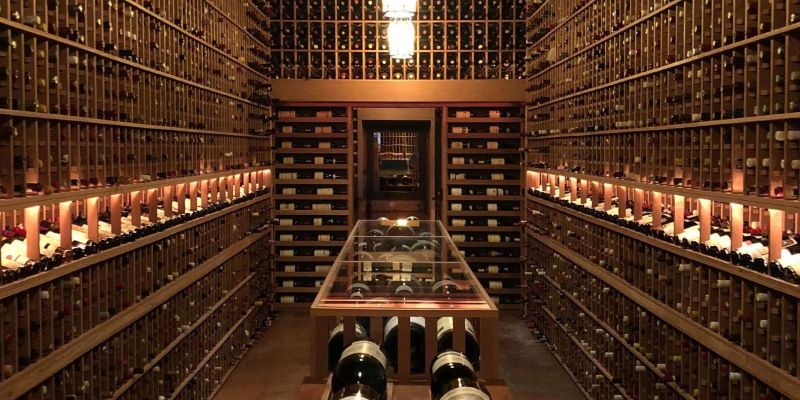
Cellar management is a critical aspect of wine stewardship, encompassing the art and science of preserving and aging wines to perfection. For wine professionals, whether sommeliers, cellar masters, or collectors, mastering cellar management techniques is essential for maintaining the quality and value of their wine collections. This article focuses on the complications of cellar management, exploring proven strategies for wine preservation and aging. A well-maintained cellar not only safeguards wines from premature deterioration but also enhances their complexity and character over time. From temperature and humidity control to bottle orientation and inventory organization, every aspect of cellar management plays a vital role in ensuring optimal conditions for wine storage. Additionally, understanding the unique preservation and aging requirements of different wine varietals is crucial for achieving the desired flavor development and aging potential.
Effective cellar management is paramount in ensuring the preservation and aging of wines to their fullest potential. A well-maintained cellar provides the ideal environment for wines to evolve gracefully, with stable temperature and humidity levels safeguarding against premature aging or deterioration. Beyond preservation, careful cellar management allows for the organization and accessibility of wine collections, enabling wine professionals to track inventory efficiently, monitor aging progress, and curate selections tailored to customer preferences. Moreover, proper cellar management enhances the overall customer experience, as consumers can trust in the quality and integrity of the wines offered. Ultimately, mastering cellar management is not just about storing bottles, it's about upholding the legacy of each wine, from vineyard to glass, and ensuring that every pour is a testament to the artistry and craftsmanship of winemaking.
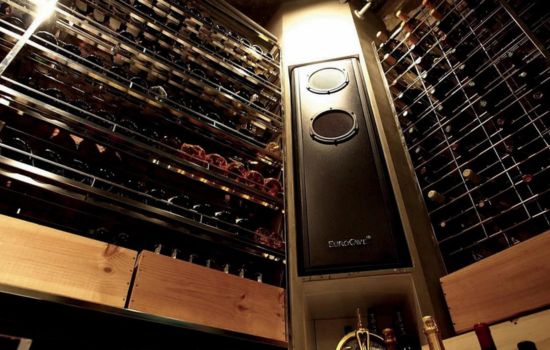
Source: EuroCave
Maintaining optimal cellar conditions is essential to preserve wines' quality and aging potential. Temperature control is the most critical aspect of cellar management. Wine is highly sensitive to temperature fluctuations, which can accelerate chemical reactions and lead to premature aging or spoilage. Ideally, cellars should be kept at a consistent temperature of around 55°F (13°C). For larger commercial cellars or even small residential ones, investing in temperature control systems, such as climate-controlled refrigeration units or passive cellar cooling systems, ensures that wines are stored at the ideal temperature year-round.
Humidity management is another essential consideration in cellar conditions. Proper humidity levels are crucial for preserving cork integrity and preventing label damage. Cellars with excessively low humidity levels risk drying out corks, which can lead to oxidation and wine spoilage. On the other hand, high humidity can promote mold growth and label deterioration. Utilizing humidity monitoring devices and implementing humidity regulation techniques, such as installing humidifiers or dehumidifiers as needed, helps maintain an optimal humidity range of 50-80%.
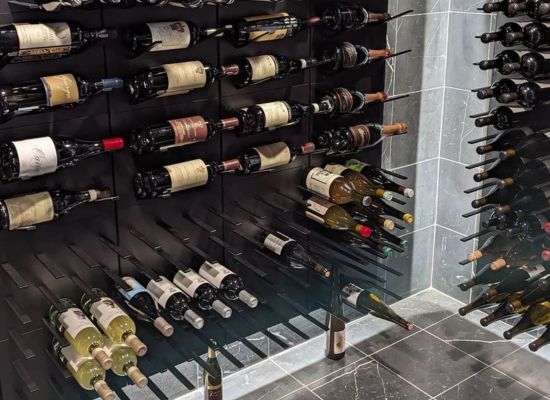
Source: Stact
The orientation in which wine bottles are stored can significantly impact their aging process. Horizontal storage, where bottles are laid on their sides, is preferred for long-term aging. This position keeps the cork in contact with the wine, ensuring a consistent seal and preventing it from drying out. Additionally, horizontal storage helps distribute any sediment that may form over time, preventing it from settling in one area of the bottle. Vertical storage, while space-saving, can lead to cork deterioration and an increased risk of oxidation.
Light exposure is another factor to consider when storing wine bottles. UV light, whether natural sunlight or artificial indoor lighting, can degrade the quality of wine over time by causing chemical reactions that result in off-flavors and aromas. To mitigate this risk, cellars should be equipped with light-blocking measures, such as tinted glass doors or windows, UV-filtering film, or opaque storage containers. By minimizing light exposure, wine professionals can ensure that their collections remain fresh and unaffected by photodegradation.
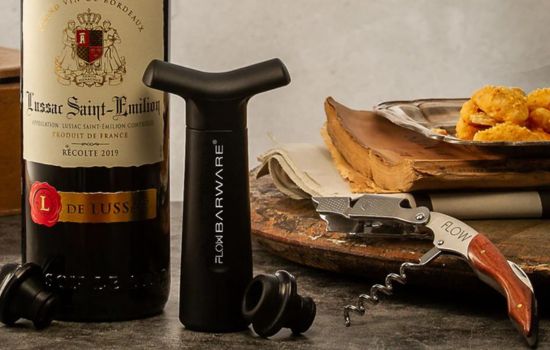
Source: Flow Barware
Preserving the integrity of opened wine bottles is essential for minimizing waste and maximizing enjoyment. Vacuum pump systems are a popular choice for prolonging the lifespan of opened bottles by removing excess oxygen from the bottle's airspace. By creating a vacuum seal, these systems help slow down oxidation, preserving the wine's freshness and flavor profile. High-quality vacuum pumps, such as those equipped with wine-specific accessories like rubber stoppers or wine bottle caps, offer the most effective preservation results.
Inert gas blanketing is another widely used preservation technique for opened bottles. By replacing the oxygen in the bottle with an inert gas, such as argon or nitrogen, inert gas systems create a protective barrier that prevents oxidation without altering the wine's taste or aroma. Wine professionals can easily administer inert gas by inserting a gas nozzle into the bottle and releasing a brief burst of gas before resealing the bottle with a cork or cap. This method is particularly effective for preserving delicate wines with high aromatic profiles, such as white wines or aged reds.
Effective inventory management and rotation practices are essential for maintaining a well-organized cellar and ensuring that wines are enjoyed at their peak. Clear labeling and organization systems are the backbone of efficient inventory tracking. In cellars of all sizes, from residential to commercial, meticulous attention to detail is necessary to keep track of each bottle's location, vintage, and quantity. For example, categorizing wines by region, varietal, or vintage can simplify inventory management and facilitate quicker retrieval when needed. Utilizing software solutions for digital cellar management streamlines the inventory process, allowing wine professionals to easily input, update, and track their collections.
Rotation practices play a crucial role in preserving wine quality and preventing spoilage. Rotating stock ensures that older bottles are consumed before newer ones, minimizing the risk of wines aging past their prime. Implementing FIFO and LIFO rotation methods helps maintain inventory freshness and reduces the likelihood of finding forgotten bottles past their peak. Monitoring inventory turnover rates provides valuable insights into consumer preferences and allows wine professionals to adjust purchasing strategies accordingly, ensuring a well-curated selection that meets the demands of their clientele.
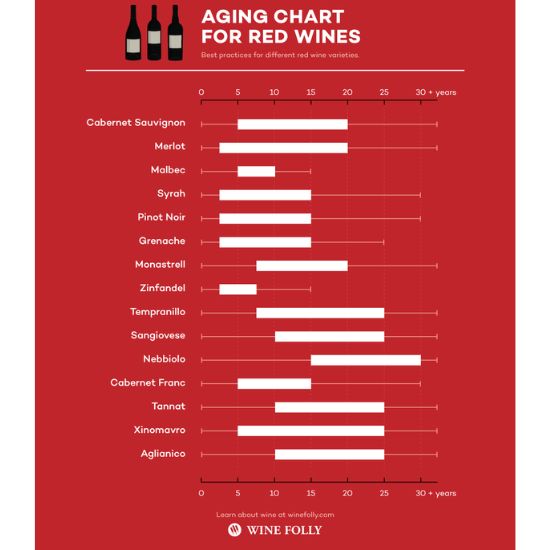
Source: Wine Folly
Understanding the aging potential of wines is essential for determining the optimal storage conditions and consumption timeline. Several factors influence a wine's ability to age gracefully, including grape variety, tannin levels, acidity, and sugar content. For example, full-bodied red wines with high tannin levels, such as Cabernet Sauvignon or Nebbiolo, typically have excellent aging potential due to their structure and acidity. Conversely, light-bodied white wines, like Sauvignon Blanc or Pinot Grigio, are best enjoyed in their youth when their fresh fruit flavors are most vibrant. Recognizing the difference between wines meant for immediate consumption and those suitable for aging is crucial for cellar management. While some wines are crafted to be enjoyed young and fresh, others benefit from extended aging, developing complex flavors and aromas over time. Establishing guidelines for determining the optimal aging window for different wine styles helps wine professionals advise customers on when to enjoy their purchases for maximum enjoyment.
Mastering cellar management is a multifaceted initiative that requires careful attention to detail, dedication to best practices, and a deep understanding of wine preservation and aging principles. By implementing these strategies, wine professionals can elevate their cellar management skills and safeguard the quality and integrity of their collections for years. From controlling temperature and humidity to implementing effective preservation techniques for opened bottles, every aspect of cellar management contributes to the overall success of a wine program. By prioritizing proper storage conditions, organizational excellence, and regular assessment of aging potential, wine professionals can ensure that each bottle reaches its full potential, delighting enthusiasts with exceptional flavors and aromas. In the dynamic world of wine, mastering the cellar is not only a testament to the dedication and expertise of wine professionals but also a celebration of the timeless art of preserving and aging wines to perfection. With a commitment to excellence and a passion for viniculture, every cellar can become a sanctuary for exceptional wines, enriching experiences and creating lasting memories for connoisseurs around the world.
Header Image Source: Minuman